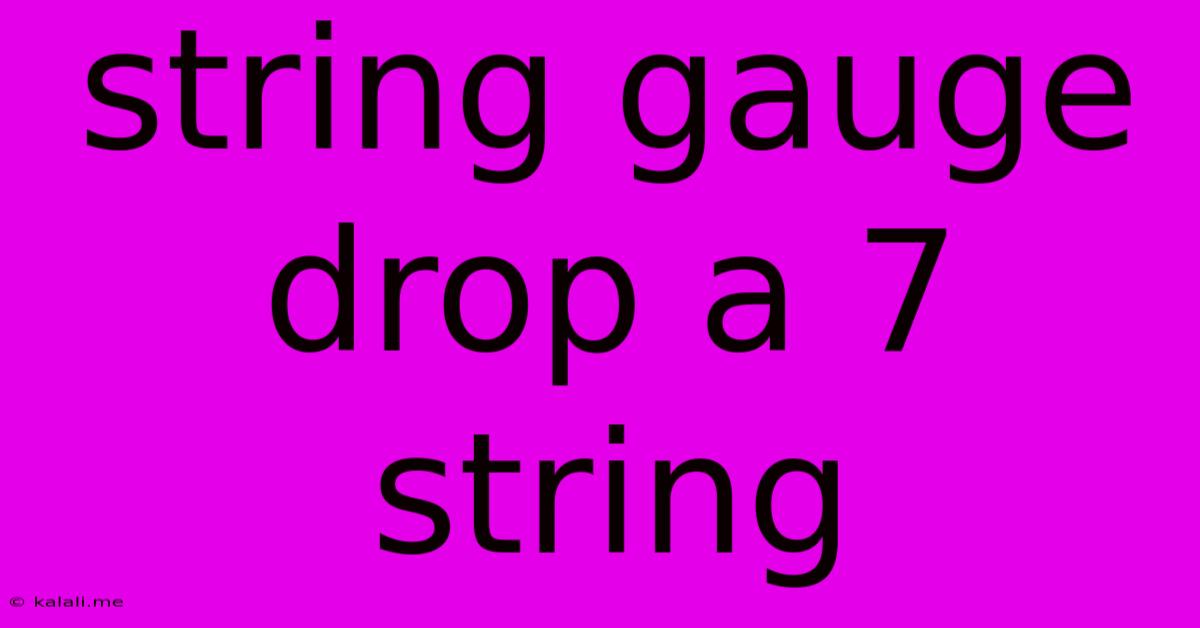String Gauge Drop A 7 String
Kalali
Jun 08, 2025 · 3 min read

Table of Contents
Dropping the 7-String: A Guide to String Gauge Selection
Choosing the right string gauge for your 7-string guitar is crucial for achieving the desired tone and playability, especially when dropping the tuning. This guide will help you navigate the world of string gauges and make informed decisions based on your specific needs and tuning preferences. Whether you're aiming for the chugging heaviness of djent or the soaring melodies of progressive metal, finding the optimal string gauge is key to unlocking your 7-string's full potential.
Understanding String Gauge and Tuning
String gauge refers to the diameter of the string, typically measured in thousandths of an inch. A heavier gauge string (e.g., .060) is thicker and produces a lower, tighter tone, while a lighter gauge (e.g., .050) is thinner and produces a brighter, floppier tone. Dropping your 7-string tuning, meaning lowering the pitch of all strings, necessitates careful consideration of string gauge to avoid excessive string slack and loss of tension. Too much slack leads to poor intonation, unwanted buzzing, and a muddy tone.
Common 7-String Tunings and Gauge Recommendations
Here's a breakdown of common 7-string tunings and suggested string gauge ranges. Remember these are guidelines – your personal preference and playing style may influence your final choice.
Standard 7-String Tuning (B Standard): B, E, A, D, G, B, e
- Gauge Range: .009 - .056 to .010 - .060
Drop A Tuning: A, D, G, C, F, A, d
- Gauge Range: .010 - .068 to .011 - .074 (Heavier gauges are generally recommended for drop tunings due to increased string tension requirements)
Drop G Tuning: G, C, F, A#, D#, G, c
- Gauge Range: .011 - .074 to .012 - .080 (Even heavier gauges often required for optimal tuning stability)
Factors Affecting String Gauge Choice:
- Tuning: Lower tunings require heavier gauges to maintain tension and prevent excessive string slack.
- Wood Type: Different guitar woods will affect the overall tone and feel, influencing your gauge preference. A mahogany body might benefit from slightly heavier gauges for a more balanced tone.
- Scale Length: Longer scale length guitars can handle heavier gauges better than shorter scale guitars, as the increased tension is distributed over a greater distance.
- Playing Style: Aggressive playing styles may benefit from heavier gauges for enhanced durability, while lighter gauges may suit intricate fingerstyle playing better.
- Personal Preference: Ultimately, the best string gauge is the one that feels comfortable and sounds best to you. Experiment with different gauges to find what works best for your playing style and preferred tone.
Experimentation is Key:
Don't be afraid to experiment with different string gauges to find your sweet spot. Start with a gauge within the recommended range and gradually adjust until you achieve the desired tone and playability. Consider purchasing a sample pack of different gauges to test various combinations.
Beyond Gauge:
Remember that string gauge is only one factor. Other elements, like string material (nickel, stainless steel, etc.) and winding type also contribute to the overall tone. Experimenting with these factors will further refine your sound.
By understanding the relationship between string gauge and tuning, and considering the other relevant factors, you can confidently select the ideal string gauge for your 7-string guitar, ensuring optimal performance in any tuning, from standard B to the deepest drop tunings.
Latest Posts
Latest Posts
-
Do Dogs Run Away To Die
Jun 09, 2025
-
Can Wolves See In The Dark
Jun 09, 2025
-
Ratio Of Coffee To Water French Press
Jun 09, 2025
-
How To Change Google Map Label Symbol
Jun 09, 2025
-
Not Enough Hot Water From Water Heater
Jun 09, 2025
Related Post
Thank you for visiting our website which covers about String Gauge Drop A 7 String . We hope the information provided has been useful to you. Feel free to contact us if you have any questions or need further assistance. See you next time and don't miss to bookmark.